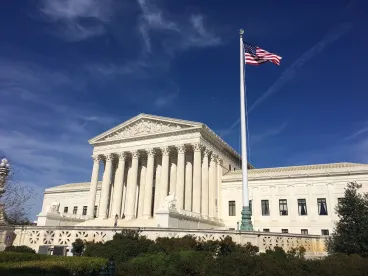In a 5-4 decision, the United States Supreme Court has ruled that governmental agencies are still entitled to deference in interpreting their own regulations—but only where those regulations are “genuinely ambiguous.” Kisor v. Wilkie, No. 18-15, --- S. Ct. ---- (U.S. June 26, 2019). Although the case involves a disability benefits appeal brought by a Vietnam War veteran, the majority decision, written by Justice Kagan, states clearly that the facts have little bearing on the significance and scope of the decision. The level of deference courts will provide to federal agencies in interpreting their own rules has broad ranging impacts, particularly in the environmental realm. This alert provides an overview of so-called Auer deference, the new constraints the majority decision in Kisor places on that deference, and the future of agency rule interpretation in the environmental field.
Historical Context
In recent decades, many significant developments in federal environmental law have occurred through executive agency rulemaking. Congress has often drafted environmental statutes in broad terms, leaving to the Environmental Protection Agency and other federal agencies the important task of determining how to translate broad and sometimes ambiguous statutory language into concrete and actionable requirements. The resulting environmental rules are consequential for business and inevitably the subject of extensive litigation.
Courts review challenges to agency interpretations of their own rules under a framework developed by the Supreme Court in which agency interpretations are accorded a level of deference. When judicial deference applies, a court will treat an agency’s interpretation of an ambiguous regulatory provision as controlling so long as it is reasonable or at times even just plausible, even if another interpretation is better in the court’s view. The Supreme Court first established the judicial deference doctrine for agency interpretations of their own regulations in the 1945 decision Bowles v. Seminole Rock & Sand Co., 325 U. S. 410 (1945), which was expanded and extended in the 1997 decision Auer v. Robbins, 519 U.S. 452. This doctrine is now known as “Auer deference.” When issued, these decisions were not controversial among the members of the Court: they were adopted by unanimous votes of the then-sitting justices (although one justice concurred in Seminole Rock). The Auer decision was written by the late Justice Scalia.
Auer deference is premised on the presumed expertise of executive agencies in their respective areas of jurisdiction and thus has been particularly important in environmental cases, where technical conclusions often inform and underlie policy judgments. For many years now, federal courts have generally deferred to environmental agencies to resolve often highly technical regulatory ambiguities, on the basis of Auer deference.
Auer deference has come under increasing criticism in recent years as concerns have developed in some segments about the extent of federal agency authority. Critics have argued that Auer tips the scales of justice in favor of the government; denies litigants the benefits of independent judicial judgments; and encourages agencies to issue vague regulations, which can later be interpreted on an ad hoc basis. Supporters of Auer have argued that the process of developing rules to interpret generalized statutory language inevitably raises questions of interpretation; that Congress generally wants the relevant agencies to play the primary role in resolving regulatory ambiguities (and has written its statutes to allow for this); and that agencies would not wish to invite litigation by intentionally issuing vague rules.
In Kisor, the Court directly considered whether to overrule Auer deference. A 5-4 majority of the Court, a slim majority joined only in part by Chief Justice Roberts, declined to overrule the Auer decision. The majority did not, however, leave Auer deference untouched. Instead, in preserving the Auer framework, the majority articulated significant constraints on the doctrine, stating an intent to “reinforce its limits.” The dissenting justices, led by Justice Gorsuch, colorfully described their view of the result: “the doctrine emerges maimed and enfeebled—in truth, zombified.”
The majority and concurring opinions make clear that the Court’s decision in Kisor concerned only Auer deference; the decision does not affect agency interpretations of statutory language under Chevron, U.S.A., Inc. v. Natural Resources Defense Council, Inc., 467 U.S. 837 (1984).
New Constraints on Auer Deference
Kisor establishes a multi-part framework for reviewing agency rule interpretations. The Court’s majority identified a more rigorous analysis than previously existed that will apply when a court is called upon to review an agency’s regulatory interpretation. Justice Kagan, writing for the majority, indicated that the decision restated and somewhat expanded upon the prior Auer deference principles. In the eyes of the majority, deference will not be granted reflexively; instead, courts will be obligated “to perform their reviewing and restraining functions.” The majority indicated that this analysis should be comprised of three separate steps.
Is the Regulation Genuinely Ambiguous?
First, a court must determine that the regulation at issue is “genuinely ambiguous.” In other words, a court must utilize all of the tools of statutory construction—the text, structure, history, and purpose of the provision, “as if it had no agency to fall back on.” In a passage that will ring true to anyone involved in environmental work, Justice Kagan writes:
A court cannot wave the ambiguity flag just because it found the regulation impenetrable on first read. Agency regulations can sometimes make the eyes glaze over. But hard interpretive conundrums, even relating to complex rules, can often be solved…
If the regulatory ambiguity can be resolved by a close reading in this manner, then no deference is due.
Is the Agency Interpretation Reasonable?
Second, if the regulatory ambiguity cannot be resolved using rules of statutory construction, the court must then find that the agency interpretation falls within the bounds of reasonable interpretation. The majority opinion makes clear that this is not a low bar. Merely finding that an interpretation is not plainly erroneous is not sufficient at this stage of the analysis.
Is the Agency Interpretation Entitled to Controlling Weight?
Third, if the court has determined that the regulatory ambiguity cannot be resolved using statutory construction rules and that the proposed agency interpretation is reasonable, the court must then independently evaluate whether the character and context of the agency interpretation entitles it to controlling weight. No fixed test governs this evaluation, but several factors are provided:
-
Is the interpretation the agency’s official or authoritative position rather than an ad hoc statement or a statement from someone not empowered to set policy for the agency?
-
Does the interpretation implicate the agency’s substantive expertise?
-
Is the interpretation:
-
A fair and considered judgment?
-
Not a convenient litigating position or post hoc rationalization?
-
Generally not a new position that creates unfair surprise to regulated parties or conflicts with a prior position?
-
A court may elect to defer to an agency judgment to resolve a regulatory ambiguity provided that the analysis survives a balancing of these factors.
Thus, after Kisor, courts may still defer to agency interpretations; however, the circumstances in which they will do so will be much more limited.
The Future of Auer Deference?
The swing vote on the Kisor decision was that of Chief Justice Roberts. His view of the case was likely swayed in large part by his institutional interest in defending the Court’s adherence to the principle of stare decisis, the concept that consistency in following prior Court precedent strengthens the rule of law and the stature of the Court.
The majority opinion noted that to overrule Auer, the Court would need to overturn a long line of precedent going back at least 75 years, and such a decision would create uncertainty about many now-settled constructions of regulatory language. However, the majority also noted that Congress could change the law at any time because the Court was not deciding a constitutional matter. The majority pointed out that Congress has had this option for nearly 100 years yet it had never acted to reduce agency discretion.
A sharply worded dissenting opinion by Justice Gorsuch, joined by Justice Thomas, and in part by Justices Alito and Kavanaugh, argued that the requirements imposed by the majority signal the death of Auer. Courts, the dissent suggests, “will rarely, if ever, have to defer to an agency regulatory interpretation that differs from what they believe is the best and fairest reading.”
Kisor will not be the last time judicial deference comes before the court, as some justices strongly question the premise of the doctrine. The dissent argued at length that Auer is incompatible with the Administrative Procedure Act and the Constitution because it is the role of the courts to interpret the law.
Takeaways
Kisor reframes the analysis that courts will use to evaluate agency interpretations of their own rules and the decision makes agency judgments more susceptible to critical review by the judiciary. Agency interpretations that are not reasonable, or that are not announced formally and by senior officials, with sufficient time and notice to prevent surprise to the regulated community, will be subject to much closer and more critical scrutiny. This decision creates some uncertainty about the strength of many existing agency interpretive decisions, and future agency rule interpretations presumably will be structured and released in a manner that more closely follows the framework created by this decision.





 />i
/>i

